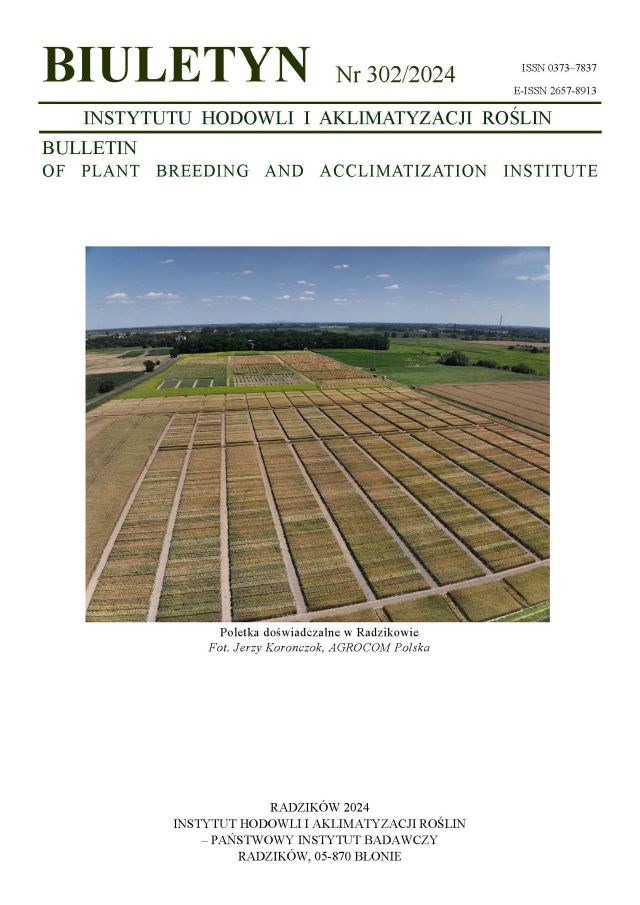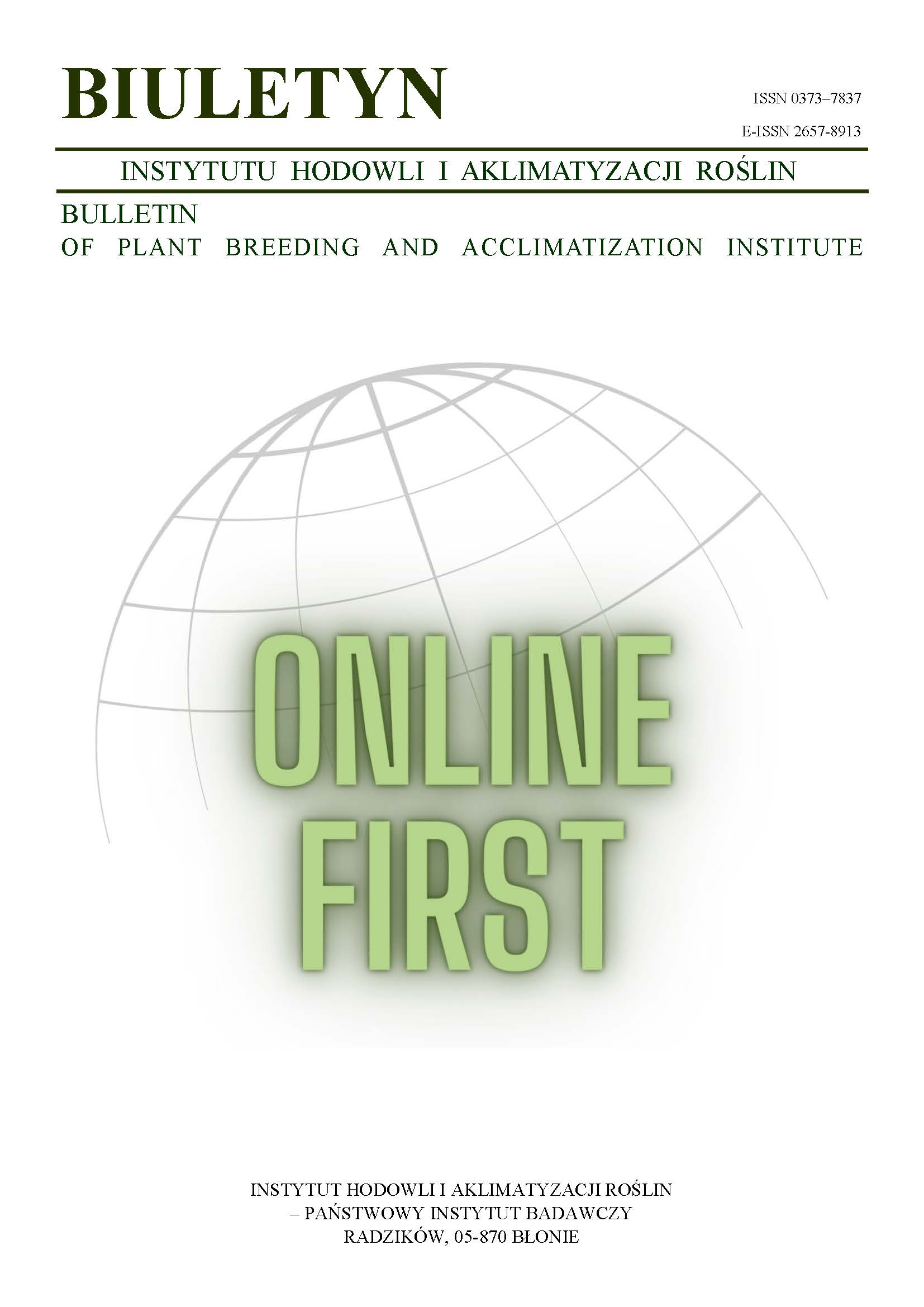Określenie reakcji nowych rodów i odmian pszenicy jarej na wybrane czynniki agrotechniczne
Alicja Sułek
iung@iung.pulawy.plZakład Uprawy Roślin Zbożowych, Instytut Uprawy, Nawożenia i Gleboznawstwa w Puławach (Poland)
Abstrakt
W latach 1999–2002 przeprowadzono doświadczenia, których celem było określenie wymagań agrotechnicznych nowych rodów i odmian pszenicy jarej odnośnie terminu siewu, ilości wysiewu i dawki nawożenia azotem. Stwierdzono, że badane rody i odmiany pszenicy jarej wykazywały różną reakcję na czynniki agrotechniczne, co pozwoliło na wydzielenie grup odmian reagujących odmiennie. Pod względem reakcji na termin siewu badane rody i odmiany zakwalifikowano do trzech grup. Grupa pierwsza — rody wrażliwe na każde opóźnienie terminu siewu poza termin optymalny (KOC 5500, KOH 1700, KOC 1800, Korynta), grupa druga — znoszące opóźnienie terminu siewu do 10 dni: Napola, Zebra, Żura, KOC 5900, grupa trzecia — mało wrażliwe na opóźnienie terminu siewu: KOH 2000. Pod względem wymagań odnośnie ilości wysiewu uwzględnione w badaniach rody i odmiany zaliczono do dwu grup: wymagające mniejszej ilości wysiewu: Napola, Korynta, Żura, KOC 5500, KOC 5900, KOH 1800, KOH 1700, KOH 2000; wymagające większej ilości wysiewu — Zebra. Pod względem wymagań dotyczących nawożenia azotem badane rody zaliczono do grupy produktywnie wykorzystującej średnie dawki nawożenia azotem — Korynta, Napola, Zebra, Żura, KOC 5500, KOH 1700, KOH 1800 oraz produktywnie wykorzystujące duże dawki nawożenia azotem — KOH 2000 i KOC 5900.
Słowa kluczowe:
gęstość siewu, nawożenie azotem, odmiany, rody, plon ziarna, pszenica jara, struktura plonu, termin siewuBibliografia
Jaskulski D. 1999. Wpływ terminu siewu oraz nawożenia azotem na plonowanie pszenicy jarej w warunkach małej ilości opadów. Pam. Puł. 118: 167 — 172.
Google Scholar
Mazurek J., Sułek A. 1995. Wpływ ilości wysiewu na plonowanie i strukturę plonu nowych odmian pszenicy jarej. Biul. IHAR 194: 89 — 93.
Google Scholar
Mazurek J., Sułek. 1995. Wpływ nawożenia azotem na plonowanie i strukturę plonu nowych odmian pszenicy jarej. Biul. IHAR 194: 95 — 98.
Google Scholar
Mazurek J., Sułek A. 1997. Wpływ głównych czynników agrotechnicznych na plon i cechy struktury plonu nowych odmian pszenicy jarej. Biul. IHAR 204: 81 — 88.
Google Scholar
Mazurek J., Sułek A. 2000. Plon i cechy struktury plonu odmian i rodów pszenicy jarej w zależności od terminu siewu. Biul. IHAR 214: 79 — 83.
Google Scholar
Michalski T. 1999. Struktura plonu pszenicy jarej uprawianej w siewie czystym i mieszankach w zależności od gęstości siewu. Pam. Puł. 118: 275—283.
Google Scholar
Wróbel E., Szempliński W. 1999. Plonowanie i wartość technologiczna ziarna pszenicy ozimej nawożonej zróżnicowanymi dawkami azotu. Pam. Puł. 118: 463 — 469.
Google Scholar
Autorzy
Alicja Sułekiung@iung.pulawy.pl
Zakład Uprawy Roślin Zbożowych, Instytut Uprawy, Nawożenia i Gleboznawstwa w Puławach Poland
Statystyki
Abstract views: 67PDF downloads: 30
Licencja
Prawa autorskie (c) 2004 Alicja Sułek

Utwór dostępny jest na licencji Creative Commons Uznanie autorstwa – Na tych samych warunkach 4.0 Miedzynarodowe.
Z chwilą przekazania artykułu, Autorzy udzielają Wydawcy niewyłącznej i nieodpłatnej licencji na korzystanie z artykułu przez czas nieokreślony na terytorium całego świata na następujących polach eksploatacji:
- Wytwarzanie i zwielokrotnianie określoną techniką egzemplarzy artykułu, w tym techniką drukarską oraz techniką cyfrową.
- Wprowadzanie do obrotu, użyczenie lub najem oryginału albo egzemplarzy artykułu.
- Publiczne wykonanie, wystawienie, wyświetlenie, odtworzenie oraz nadawanie i reemitowanie, a także publiczne udostępnianie artykułu w taki sposób, aby każdy mógł mieć do niego dostęp w miejscu i w czasie przez siebie wybranym.
- Włączenie artykułu w skład utworu zbiorowego.
- Wprowadzanie artykułu w postaci elektronicznej na platformy elektroniczne lub inne wprowadzanie artykułu w postaci elektronicznej do Internetu, lub innej sieci.
- Rozpowszechnianie artykułu w postaci elektronicznej w internecie lub innej sieci, w pracy zbiorowej jak również samodzielnie.
- Udostępnianie artykułu w wersji elektronicznej w taki sposób, by każdy mógł mieć do niego dostęp w miejscu i czasie przez siebie wybranym, w szczególności za pośrednictwem Internetu.
Autorzy poprzez przesłanie wniosku o publikację:
- Wyrażają zgodę na publikację artykułu w czasopiśmie,
- Wyrażają zgodę na nadanie publikacji DOI (Digital Object Identifier),
- Zobowiązują się do przestrzegania kodeksu etycznego wydawnictwa zgodnego z wytycznymi Komitetu do spraw Etyki Publikacyjnej COPE (ang. Committee on Publication Ethics), (http://ihar.edu.pl/biblioteka_i_wydawnictwa.php),
- Wyrażają zgodę na udostępniane artykułu w formie elektronicznej na mocy licencji CC BY-SA 4.0, w otwartym dostępie (open access),
- Wyrażają zgodę na wysyłanie metadanych artykułu do komercyjnych i niekomercyjnych baz danych indeksujących czasopisma.
Inne teksty tego samego autora
- Alicja Sułek, Reakcja nowych odmian owsa na nawożenie azotem w doświadczeniach wazonowych , Biuletyn Instytutu Hodowli i Aklimatyzacji Roślin: Nr 253 (2009): Wydanie regularne
- Grażyna Cacak-Pietrzak, Alicja Sułek, Wpływ poziomu nawożenia azotem na plonowanie i jakość technologiczną ziarna pszenicy jarej , Biuletyn Instytutu Hodowli i Aklimatyzacji Roślin: Nr 245 (2007): Wydanie regularne
- Alicja Sułek, Danuta Leszczyńska, Stan aktualny i perspektywy uprawy owsa w Polsce , Biuletyn Instytutu Hodowli i Aklimatyzacji Roślin: Nr 231 (2004): Wydanie regularne
- Alicja Sułek, Wpływ dawek azotu na plon ziarna i jego komponenty u nowych odmian owsa , Biuletyn Instytutu Hodowli i Aklimatyzacji Roślin: Nr 229 (2003): Wydanie specjalne














